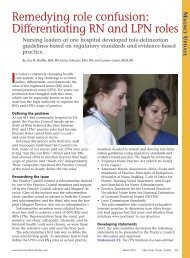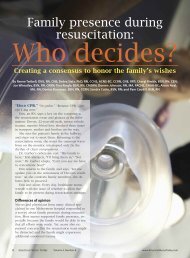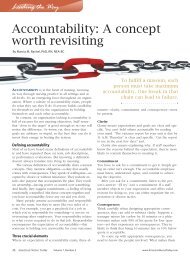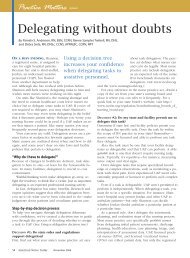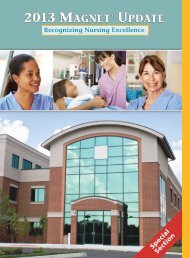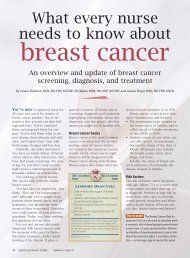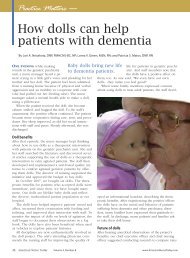2009 MAGNET™ PROFILES - American Nurse Today
2009 MAGNET™ PROFILES - American Nurse Today
2009 MAGNET™ PROFILES - American Nurse Today
You also want an ePaper? Increase the reach of your titles
YUMPU automatically turns print PDFs into web optimized ePapers that Google loves.
MAGNET <strong>PROFILES</strong><br />
Mission: Achieve continual<br />
readiness for Joint Commission<br />
surveys<br />
An impossible goal? Perhaps not, if you follow the author’s<br />
“E” approach.<br />
By Barbara C. Sorbello, PhD, RN-BC, NEA-BC<br />
It’s 8:30 A.M. Monday, and the hospital is bustling.<br />
The operating room has a heavy schedule. Six emergency-department<br />
patients have been admitted and<br />
await open beds. All of a sudden, you hear “Code J” announced<br />
over the PA system—and the nightmare begins.<br />
The nurse manager on 2-North starts barking orders<br />
to her staff. “Peter, clear the hallways and hide the<br />
Christmas decorations in the storage room. Julie, make<br />
sure our I.V. sites and irrigation sets are dated. Cathy,<br />
check the charts and see if all our patients have up-todate<br />
care plans and discharge plans.”<br />
The charge nurse scrambles to verify that the crash cart<br />
logs and refrigerator logs have been completed. “Oh my<br />
gosh!” she suddenly exclaims. “Who took the refrigerator<br />
thermometer? And where did all this old food come from?”<br />
Meanwhile, the nurse manager heads for the medication<br />
room to check drug expiration dates. She finds<br />
the medication cabinets unlocked and sees donuts and<br />
spilled coffee on the counter. Taking a deep breath to<br />
calm herself, she opens the cupboard under the sink.<br />
There she spots unit supplies, a box of cookies, and<br />
staff members’ purses. No amount of deep breathing<br />
can prevent her from losing her cool now!<br />
Most of you can relate to this tale of a surprise<br />
Joint Commission (JC) visit. It could happen on<br />
any nursing unit on any given day. Meeting the<br />
myriad standards and regulations established for<br />
healthcare facilities by federal, state, and local<br />
agencies can be challenging enough. Keeping staff<br />
members in continual readiness for an unannounced<br />
survey may seem nearly impossible.<br />
Yet being in a continual state of readiness diminishes<br />
the stress of last-minute preparations. This article<br />
describes how nurse leaders can make sure<br />
their staffs are perpetually prepared—and confident—for<br />
surprise surveys.<br />
JC’s survey approach<br />
In 2004, the JC rolled out a new survey approach:<br />
Their surveyors now spend more time reviewing patient-care<br />
activities, processes, and outcomes by using<br />
“tracer” methods and talking with staff members involved<br />
in direct patient care. Tracer surveyors trace<br />
the care processes patients experience during the continuum<br />
of their hospital stays and discuss standards<br />
with the care providers closest to the patient situation.<br />
In 2006, JC began its unannounced survey<br />
process, in which facilities don’t have the luxury of<br />
preparing for surveys. Long gone are the days<br />
when JC surveyors sat in a hospital’s conference<br />
room all day reviewing manuals, committee minutes,<br />
and closed patient records. Now they spend<br />
less time on document review and more time discussing<br />
effective care with clinicians.<br />
Many healthcare organizations have created<br />
teams linked to each JC standard of care. The teams<br />
conduct gap analysis and develop performance improvement<br />
plans for organizational readiness related<br />
to the assigned standard. This strategy promotes a<br />
systems-oriented approach to process improvement<br />
and quality outcomes. Unit leaders and staff members<br />
are responsible for implementing the teams’ recommendations<br />
and conducting unit-based initiatives<br />
to ensure high-quality care at the unit level.<br />
Developing a culture of readiness<br />
Continual quality improvement is a way of being, not<br />
just a periodic activity. If employees merely try to get<br />
through a survey using scripted responses, they may<br />
perceive that the survey and their participation in it<br />
have little value to themselves or their patients—an attitude<br />
not conducive to feeling engaged in the process.<br />
Instead, nurse leaders and the shared governance<br />
committee of the nursing unit must set standards<br />
for, and promote conditions that foster, a culture<br />
of safety, quality, and readiness. The focus<br />
needs to shift from merely doing what’s needed to<br />
meet requirements, to ensuring continual performance<br />
and process improvement.<br />
Using the “E” approach<br />
To achieve a culture of continual readiness for sur-<br />
(continued on page 64)<br />
62 <strong>American</strong> <strong>Nurse</strong> <strong>Today</strong> Volume 4, Number 8




